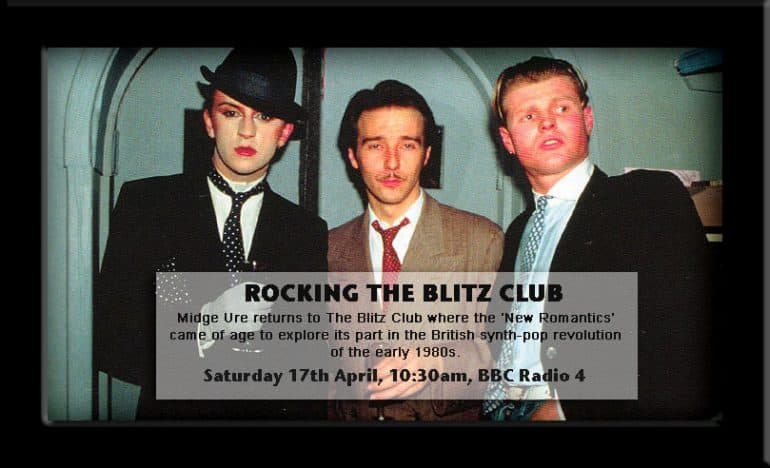The New Romantics, also known as New Wavers, Blitz Kids, and New Dandies, were adopters of the New Romantic movement, a youth fashion and music trend emerging from the UK in the late 1970s.
The growth of progressive social values that began in the later 1960s continued to thrive in the 1970s, these values including an increase in political awareness and liberty of women.
Post-Watergate, a lot of people turned away from politics. Instead, they looked up to pop culture. They enjoyed listening to 8-track tapes of Olivia Newton-John, Jackson Browne, Marvin Gaye, and Donna Summer.
Along with these, disco also became popular, producing idols such as Donna Summer, the Bee Gees and Abba. Whilst on the rock ‘n’ roll front, the Rolling Stones, Queen, and Pink Floyd dominated the airwaves.

What Was the New Romantic Movement?
The New Romantic movement that started in the 1970s in UK was seen as a pop culture movement. The movement emerged from the nightclub scene in Birmingham and London at clubs such as The Blitz and Billy’s.
The New Romantic movement was characterized by a buoyant, bold fashion that was inspired by fashion boutiques like Helen Robinson’s Covent Garden shop PX in London and fashion designers Jane Kahn and Patti Bell in Birmingham.
The New Romantic movement began almost at the same time in Birmingham and London. In London, it emerged out of Roxy Music and David Bowie music nights, which began at the nightclub called Billy’s in 1978 on Dean Street in London. In Birmingham, the beginnings of the New Romantic movement came in the opening of the Hurst Street shop of the designers Kahn and Bell in 1975.
The influence of the New Romantics seems far-reaching, despite it only lasting a couple of years. It gave birth to some of the century’s most popular pop artists from Spandau Ballet to Boy George. In a fashion sense, it introduced quite a number of the most popular trends of the decade: exuberant makeup, power silhouettes, and sharps suits.
Since the movement was transitory, it is hard to define the result of a combination from the decade’s icons like Bowie to Weimar Berlin.
The New Romantic movement is also commonly known as blitz. The culture mixed techno-pop style with an elaborate fashion sense that originated from disco club scenes. The unceasing popularity of the rock style that followed the disco period, blended with the flamboyant fashion sense the British youths exhibit, can answer why most New Romantics emerged from that time period.
Although the New Romantic movement originated in the late 1970s, it became popular in the early 1980s. The main reason for this was the receptiveness of MTV to broadcast the New Romantics video clips. MTV was established in late 1981 and faced a dearth of quality program to the product; however, in the later years, the New Romantics music soon dominated the MTV playlists and, gradually, it dominated industry sales charts and radio programming.
By the mid-1980s, the New Romantic movement waned as it was not able to compete amid the wide array of post punk elements.
The New Romantics Music
Several bands that originate from the New Romantic movement feature synthesizers, which has led to the common misunderstanding that synthpop and the New Romantic movement were the same. Synthpop was used in the 60s and 70s by the use of synthesizers in electronic art rock, progressive rock, the “Krautrock,” disco, the three albums by Bowie with Brian Eno, and the early albums of Yellow Magic Orchestra.
After Gary Numan topped in the British Singles Chart in 1979, a huge number of artists started to enjoy the fruits of their labor with a synthesizer sound, and they began to overtake the pop music of the early 1980s. Bands that came out from the New Romantic movement and used synthpop include Spandau Ballet, Visage, and Duran Duran.
The older version synthpop has been described by listeners as sterile, eerie, and menacing, using droning devices which have little change in inflection. The addition of the dance beats livened things up a lot more for a three minutes pop.
Duran Duran was the one which incorporated a dance beat rhythm into the synthpop to produce more lively music. This also earned him a list of hit singles.
Being a part of the New Romantic movement does not necessarily mean that you have to make use of synthesizers. There are bands belonging to the New Romantics who avoid synthesizers altogether or either make minimum use of them.
Culture Club, a New Romantics band, produced sounds that merged elements of Motown, lovers rock and the Philly soul while the examples of the African influenced rhythms of the “Burundi beat” are ‘Adam and the Ants’ and ‘Bow Wow Wow.’
The New Romantic movement is also sometimes seen as a product delivered by the punk rock movement. It is also largely influenced by the 1970s ex glam rock stars such as Roxy Music and David Bowie. When it comes to style, it abandoned the anti-fashion stance of punk. Both genders often dressed in flamboyant attire and use cosmetics such as lipstick and eyeliner, partially derived from former punk fashions.
The band Japan denied any link with the New Romantic movement since they are not just the way that is since their formation in the mid-1970s before the formation of the New Romantic movement.
Some contemporary bands had written lyrics that addresses social issues such as unemployment and urban decay, while the Romantics adopted an escapist and aspirational stance.
New Romantic Cultural Moments
The subculture started in 1978 in Soho when Rusty Egan and Steve Strange started hosting ‘Bowie Nights’ at Billy’s Club. Art students and teenagers are taken back to glam rock and further back to the romantic era to look for something more glamorous. This is how the scene acts as- a medium between New Romantic and punk.
The night shifted to Blitz Club by 1979. As an influence from Bowie’s constant reinventions, the door policy wanted attitude and originality. Blitz kids strive to alter their looks each week, making it hard to overtake. The subculture was launched by Blitz alone. Celebrities such as Princess Julia, Dylan Jones, Boy George, and Spandau Ballet visit the Blitz often.
Blitz Club New Romantics
‘Ashes to Ashes’ by David Bowie
As an act of taking influence on the Blitz kids back, Bowie paid Steve Strange and the other Blitz kids 50 pounds each so that he could Star in the New Romantic video dressed in ecclesiastical robes.
Spandau Ballet
Spandau Ballet is a band that came straight out from the Blitz club. The band took New Romantic mainstream to a new level and is acknowledged as the hip-pop band once more.
The Culture Club
In October 1982, The Culture Club appeared for the first time on British TV with their song titled ‘Do You Really Want to Hurt Me,’ which caused a rage in the press.
The Naked Civil Servant
The Quentin Crisp biopic, which aired in 1985 on ITV, comes under the New Romantic movement. It was made possible by John Hurt in the 1940s who openly portrayed gay images like using makeup and nail polish during the time when homosexuality was not legalized.
Leigh Bowery and Taboo
The mid-1980s produced the Taboo, which was run by the artist Leigh Bowery. The drug-influenced polysexual night ended the era of the New Romantics and opened ways for Club Kid nights such as Disco 2000 and New York’s Limelight.
The New Romantic Icons and Inspiration
Steve Strange
Steve Strange was the club’s doorman, and Egan served as the DJ at the Blitz club. The exclusive door policy, as well as the strict dress code, signified the club. Strange often denied important patrons entry of he felt that they were not dressed well enough to mingle with the ones inside the club. In a viral incident, Steve Strange denied entry to Mick Jagger because he was drunk.
The club gave birth to a number of spin-offs, and soon there were more clubs in the capital and in other major cities in Britain, including Liverpool, Birmingham, and Manchester.
While still at Billy’s, Strange and Egan united with Midge Ure and Billy Currie of Ultravox to produce the band called Visage. Prior to forming Culture Club, Marilyn and Boy George worked as cloakroom attendants. David Bowie’s 1980 video “Ashes to Ashes,” which was the UK number-one single, had appearances by Steve Strange with three more Blitz Kids and moved the New Romantic movement into the mainstream.
Boy George
Boy George whose real name is George O’Dowd made the androgynous features of the New Romantics more famous than anybody ever had.
Kim Bowen
This fashionista, who is a writer as well as a muse to Stephen Jones, was hardly seen in the clubs without an intricate hat.
Derek Ridgers
Derek Ridgers was a British photographer who documented social moments and subcultures since the early 1970s. You can find New Romantic fashion inspiration in his wonderful book 78/87 London Youth.
The New Romantic Fashion and Popular Designers
Fashion was founded on different looks, which are inspired by historically Romantic themes, which includes, frilly and lacy shirts like the Russian constructivism, English Romantic period, French Incroyables and 1930s’ Cabaret, Bonnie Prince Charlie, Pierrot clown, Hollywood starlets, and the Puritans. Popular hairdos included quiffs, wedges, and mullets. After they began to gain attention from the mainstream, several band artists left behind the historical attires and fancied sharper suits. New Romantic looks were brought forward by the fashion designers Patti Bell and Jane Kahn in Birmingham and PX in London.
Stephen Jones
The British milliner Stephen Jones danced the nights away at Blitz for some of his earliest clients, which include John Galliano and Boy George.
Bodymap
Holah and Stevie Stewart formed Bodymap in 1982, which was inspired by the nightclub scene. Blitz Kids along with other star celebrities like Leigh Bowery, Marilyn, Boy George and Michael Clark wore and displayed their designs down the runways.
John Galliano
In the early ’80s, John Gallianova was studying at St. Martin’s, during the time of pop culture and Taboo and the designer has a collection ‘Les Incryoables’ which is named after the real dandies of France in the 18th century.
Vivienne Westwood
Although Westwood may seem more of a punk, if you look into the conversation in her two works, you will find that she still has a tie for the pop culture. ‘Pirates’ is her first collection in 1981, which had an unmistakable influence on Adam Ant’s ‘King of the Wild Frontier’, which was released in the same year.
A Cultural Revolution!
As you can see, the New Romantics movements had a huge impact on music, fashion and general culture throughout the 1960s and 70s.
Even as the official movement declined into the 1980s, its influence was well and truly entrenched in hearts and minds of people around the world – still having impacts and making contributions to music, movies and fashion in the modern era.
Now, excuse me while I dive down the rabbit hole of Duran Durans best ever songs.
Similar Stories…
- Rolan Bolan – His Life Indebted to David Bowie
- Marc Bolan & David Bowie: Glam Rock Godfathers
- Perri Lister – Face of the New Romantic Movement
- Squeeze – The Coolest of Cats
- The Alice Cooper Fact Sheet – 5 Things You Need To Know - January 12, 2023
- Everybody Knows The Words, But What Is Hotel California About? - April 29, 2022
- What Is The Meaning Of Stairway To Heaven: Led Zeppelin’s Amazing 1971 Musical Epic? - April 24, 2022


